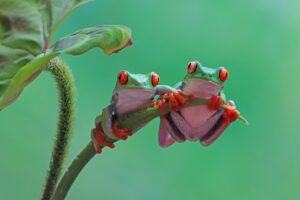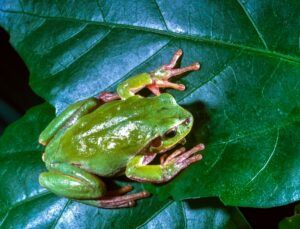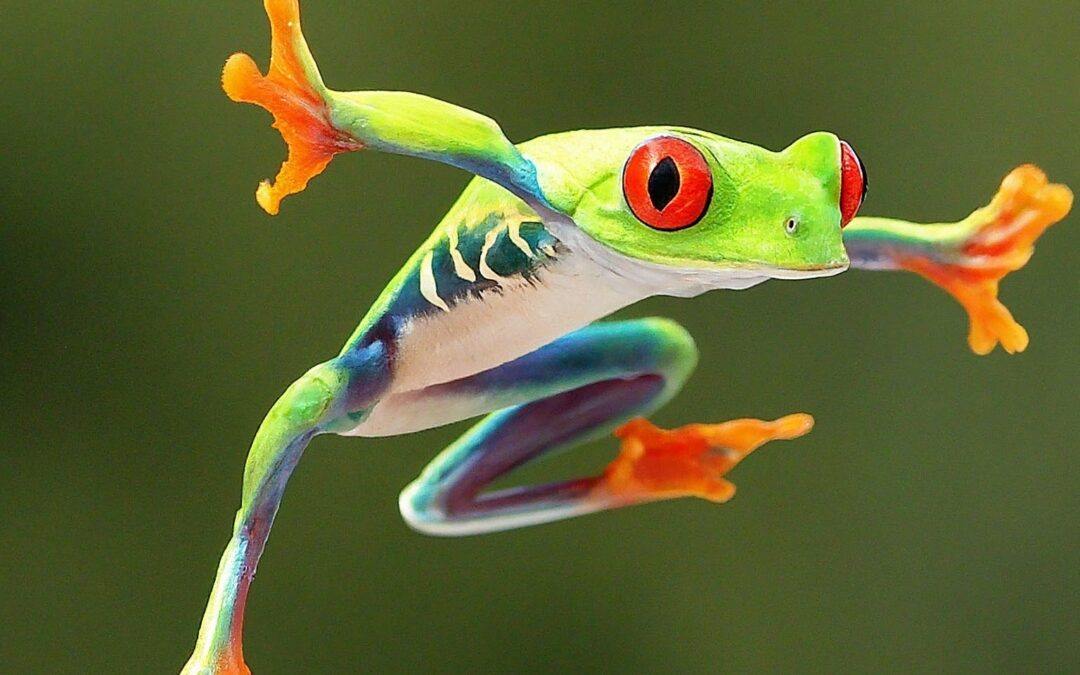How to Attract Tree Frogs to Your Garden Effectively
Are you looking to bring more life to your garden? Attracting tree frogs can add a delightful noise and help control pests naturally.
To attract tree frogs to your yard, you need to create an inviting environment with water, shelter, and plenty of insects.

Red Eyed Green Tree Frogs
A water feature, even something as simple as a small pond or a water dish, is essential.
Planting native wildflowers, shrubs, and understory ferns can give frogs a place to hide and find food.
Adding tall grass and leafy plants around trees and water sources helps create the perfect habitat for tree frogs.
For extra attraction, consider using PVC pipes to make safe shelters for the frogs.
Driving a five-foot-long PVC pipe into the ground or hanging shorter pipes in trees near water sources can simulate the tree frogs’ natural homes. This makes your yard more appealing and keeps them safe from predators.
Key Takeaways
- Frogs need water, shelter, and bugs to thrive.
- Native plants and water features create an ideal habitat.
- PVC pipes can provide additional safe living spaces.
Understanding Tree Frogs
Tree frogs are fascinating creatures known for their ability to thrive in diverse environments. They display unique habitat preferences and specific behavioral characteristics that make them a distinctive group among amphibians.
Habitat Preferences
Tree frogs often choose habitats that offer both water and vegetation. They thrive in areas with understory ferns, native wildflowers, shrubs, grasses, and other leafy plants.
These plants not only provide shelter but also attract insects, which are crucial for their diet.
Adding a water feature like a pond or even a simple terra-cotta saucer filled with water can make your yard more attractive to them.
Water nearby trees further enhances their living conditions, as it gives them a consistent source of hydration.
In some cases, installing PVC pipes or creating artificial shelters near the base of trees or along water sources can provide additional safe spaces for tree frogs.
These structures offer excellent nesting and hiding places, ensuring their safety from predators.
Behavioral Characteristics
Tree frogs are primarily nocturnal, meaning they are most active at night. During this time, they hunt for insects and other small invertebrates.
By leaving lights on at night, you can attract more bugs, providing a steady food supply for the frogs.
They are excellent climbers, using their adhesive toe pads to grip onto leaves, branches, and even slick surfaces like glass.
This climbing ability helps them evade predators and reach high perches for calling mates.
Tree frogs communicate through a variety of calls, especially during mating season.
Their croaks and calls are crucial for finding mates and establishing territory.
Understanding their behavioral patterns, like nocturnal activity and climbing habits, can help in designing a habitat that meets all their needs.
For further details on habitat preferences, you can explore tips for attracting tree frogs to your yard.

European,Tree,Frog,(hyla,Arborea)
Creating a Suitable Environment
To attract tree frogs to your backyard, it’s essential to provide an appropriate outdoor enclosure, consistent water sources, and ample plants and shelter. These factors help create a habitat where tree frogs can thrive.
Outdoor Enclosure Requirements
Tree frogs need specific conditions to feel secure. A fenced area can keep predators out and prevent frogs from wandering too far.
Use a mesh or wire that’s fine enough to stop small animals but large enough to let insects through.
A height of at least 3-4 feet for the enclosure is ideal. This gives tree frogs plenty of vertical space, which they prefer.
Ensure there are shaded areas to protect them from direct sunlight.
Water Sources and Humidity
Water is crucial for tree frogs. A small pond or water bowl can serve as their primary water source. Make sure the water is dechlorinated to avoid harming the frogs.
Consistency in humidity levels is key. Tree frogs thrive in humidity levels around 70-90%.
Misting the area regularly will help maintain this humidity.
Position the water sources near plants to provide natural shade and retain moisture.
Plants and Shelter
Plant dense vegetation in the enclosure to offer hiding spots and food. Native wildflowers, grasses, shrubs, and leafy plants are excellent choices. They provide natural shelters and attract insects for the frogs to eat.
Consider adding understory ferns and leaving leaf litter on the ground. These elements create an environment similar to a tree frog’s natural habitat.
PVC pipes can be used as shelters. Place them at different heights to mimic tree trunks and branches.
Attracting Tree Frogs Naturally
Creating a natural habitat for tree frogs involves careful garden management and focusing on insect population control. These efforts provide tree frogs with shelter, water, and food.
Garden Management
To attract tree frogs, it’s essential to create an inviting environment.
Start by incorporating a variety of native plants, such as ferns, wildflowers, shrubs, and grasses.
These plants not only provide hiding spots but also create a natural ecosystem.
Water features are crucial. A simple pond or even a water-filled saucer can serve as a reliable water source for tree frogs.
Adding a few floating plants can help maintain water quality and offer additional cover.
Providing shelters is also important. Utilizing materials like PVC pipes can create safe hiding spots for the frogs.
Insect Population Control
Tree frogs thrive in environments where insects are abundant, as they form a significant part of their diet.
Maintain outdoor lighting at night to attract bugs, which in turn attracts the frogs who feed on them.
Avoid using pesticides in your garden.
Pesticides can harm the insects that tree frogs eat and can also poison the frogs directly.
Instead, encourage a balanced ecosystem where natural predators control insect populations.
Composting yard waste can help attract insects. The decomposing organic matter draws bugs, providing a steady food supply for tree frogs.
Ensure compost bins are placed strategically to avoid attracting unwanted pests.
Supplemental Attraction Strategies
To draw tree frogs to your yard, consider using artificial lighting and providing feeding and diet supplements. These strategies can make your garden more appealing and support the frogs’ health and activity levels.
Artificial Lighting
Tree frogs are active at night and are attracted to areas with bugs.
Using solar lights in your garden can help attract moths and other insects that frogs like to eat.
Placing lights near plants and water sources will increase insect activity in those spots, making it easier for frogs to find food.
Make sure the lights are low-intensity to avoid disturbing the frogs. Too much brightness can deter them.
Opt for soft, warm lighting instead of harsh, white lights. This setup creates an inviting environment while safeguarding the natural behaviors of the frogs.
Feeding and Diet Supplements
Feeding tree frogs isn’t always necessary if your yard has a healthy insect population.
They eat bugs like crickets, moths, and flies.
To boost their diet, use compost piles to attract a variety of insects.
Compost supports a rich ecosystem where frogs can thrive by finding plenty of food naturally.
If the insect supply is low, consider buying small crickets or mealworms from pet stores to release in the yard.
These supplements help ensure the frogs have enough to eat, especially when insect populations decrease.
Avoid using pesticides in your garden to keep the food supply safe and abundant for the frogs.
Maintaining Suitable Conditions
Creating the right environment for tree frogs helps attract and keep them in your yard.
First, it’s essential to provide hiding spots. Tree frogs need safe places to escape predators.
Planting understory ferns, native wildflowers, and shrubs offers both cover and a food source as these plants attract bugs.
Water sources are vital for tree frogs. A small pond or a simple water feature like a terra-cotta saucer filled with water can make a big difference. Tree frogs need water for drinking and laying eggs.
Shelters also play an important role.
Consider driving a 5-foot long PVC pipe into the ground or hanging PVC pipes in trees, as suggested here.
These pipes should have a capped bottom and a hole for drainage.
Adding a toad house can offer extra protection.
A toad house can be made from simple materials and placed near garden areas or water sources. These houses give toads a safe and cool place to retreat during the day.
Insect availability is another crucial factor.
Tree frogs eat bugs, so maintaining a garden with plenty of plants helps attract insects.
Use compost near your garden to increase bug activity, which in turn feeds the tree frogs.
Creating the right lighting can attract insects that tree frogs eat.
Adding solar lights in your garden can attract moths, a primary food source for tree frogs. This ensures they have access to food even at night.
Monitoring and Adjusting
To ensure tree frogs continue to thrive in your yard, monitoring their population and adjusting their habitat is essential. These steps help maintain a healthy environment for the frogs and allow you to address any issues promptly.
Population Tracking
Tracking the population of tree frogs involves regular observation.
It’s essential to keep a record of how many frogs are present at different times. This can be done once a week or bi-weekly.
Use a simple journal or spreadsheet to note down your observations.
Look for any changes in the number of frogs, their behavior, and any signs of illness.
Setting up a few designated observation spots in your yard can make the process easier.
Choose areas near water sources or where you’ve seen frogs frequently. Photographing the frogs can also help in tracking individual frogs and identifying any new arrivals or absentees.
If you notice a sudden drop in the frog population, investigate possible causes such as predators, environmental changes, or a lack of food.
Addressing these issues quickly can help maintain a stable frog population.
Habitat Adjustment
Adjusting the habitat involves making necessary changes to ensure it remains suitable for tree frogs.
Regularly check the plants, water sources, and hiding spots to make sure they are in good condition.
Make sure that there are enough leafy plants and ferns around the yard since these provide both food and shelter for the frogs.
If you have added water features like ponds, ensure that the water is clean and not stagnant.
Stagnant water can attract mosquitoes, which might not be ideal.
Simple water features, such as a terra-cotta saucer filled with water, can also provide necessary hydration.
Additionally, check for pesticides or chemicals that could harm the frogs.
Replace them with natural alternatives to keep the environment safe.
Hanging or placing PVC pipes around the yard can offer additional shelters and contribute to a more frog-friendly habitat. For more details on shelter options, visit this guide on attracting tree frogs.
Conservation and Legal Considerations
When attracting tree frogs to your yard, it is important to be mindful of local regulations and conservation best practices. Compliance with laws and contributing positively to the environment ensures the wellness of both tree frogs and their habitats.
Local Regulations
Different regions have specific rules regarding the protection of wildlife, including frogs.
Homeowners need to check with local wildlife agencies or environmental departments to ensure compliance.
For example, it can be illegal to collect frog eggs or tadpoles from the wild in some areas due to species protections.
Additionally, using pesticides or fertilizers can be restricted if they harm local amphibian populations.
Maintaining a garden that complies with local bans on harmful chemicals is vital.
Being aware of these regulations helps protect frog populations and surrounding ecosystems.
Conservation Best Practices
Supporting tree frog populations involves implementing conservation-friendly practices.
Creating a habitat with diverse plants can provide frogs with shelter and food.
Introducing native vegetation such as ferns, wildflowers, and shrubs can enhance the environment.
Placing water features like ponds or ground-level birdbaths offers essential breeding sites.
Avoiding chemical usage in gardens and around water sources prevents contamination of their habitats.
Conserving natural areas like woodlands and wetlands can also aid in maintaining local biodiversity.
By supporting broader conservation efforts, property owners can contribute to healthier, more robust tree frog populations.
Link to learn more about how to attract tree frogs.
Frequently Asked Questions
When trying to attract tree frogs, it’s important to provide a safe and suitable environment that meets their needs. This includes adding water features, creating shelters, and ensuring the right environmental conditions.
What can I do to attract tree frogs to my yard?
To attract tree frogs, add native plants around the base of trees and water sources.
Plants like understory ferns, wildflowers, shrubs, and grasses provide cover and food.
What features should I include in my garden to lure frogs at night?
Adding water features such as ponds or even a simple terra-cotta saucer filled with water can attract tree frogs.
Water sources should be shallow and have plants for additional cover.
How do I create a frog-friendly habitat without a pond?
You can use buckets or containers with water plants to create a makeshift pond.
Position these in shaded areas to keep the water cool and appealing for tree frogs.
What are the best DIY tree frog houses and how do they work?
DIY tree frog houses can be made using PVC pipes.
Drive a 5-foot PVC pipe halfway into the ground near a tree or water source to provide shelter.
Alternatively, hang 2-foot PVC pipes in trees with holes for water drainage.
What environmental conditions are most conducive for tree frogs to thrive in my garden?
Tree frogs thrive in damp, cool areas with plenty of vegetation and water.
Ensure your garden has shady spots and a consistent water source to keep the environment moist.
Where are typical tree frog dwelling spots in a backyard environment?
Tree frogs often dwell near water sources and under leafy plants.
Look for them around the base of trees, in shrubs, or within water features where they can hide and stay hydrated.

